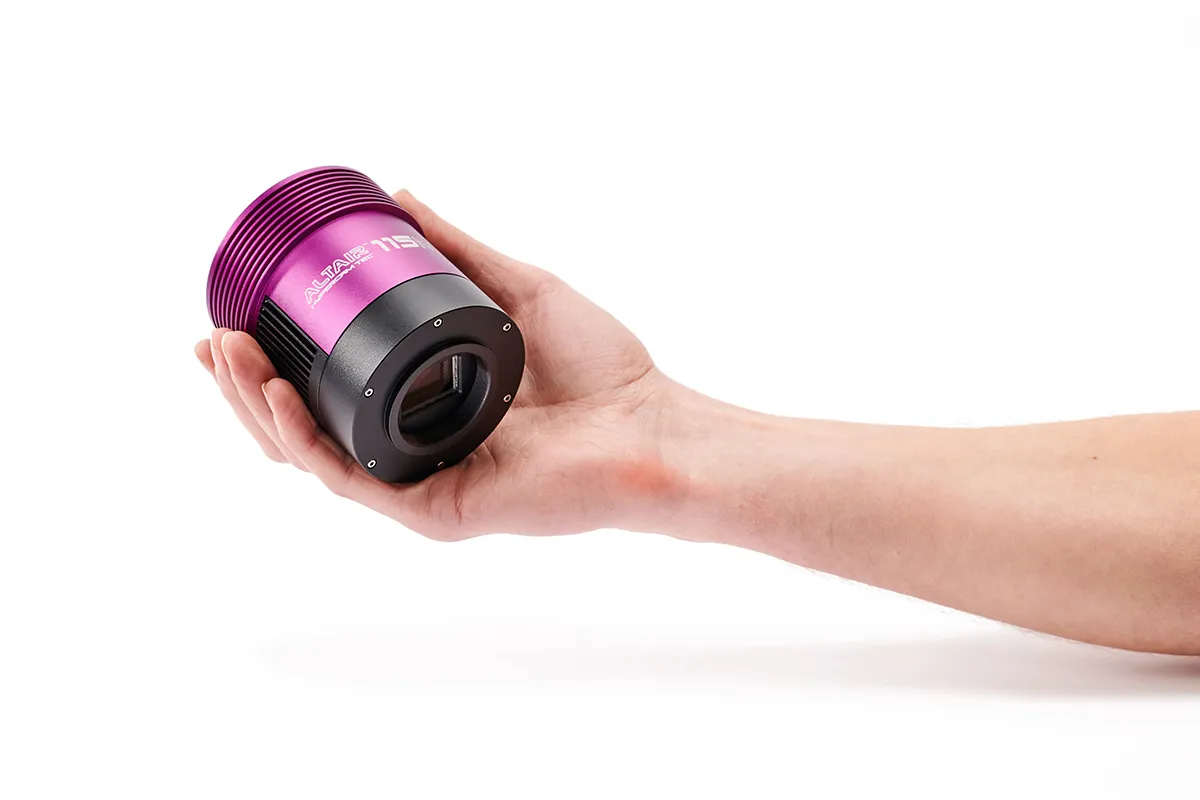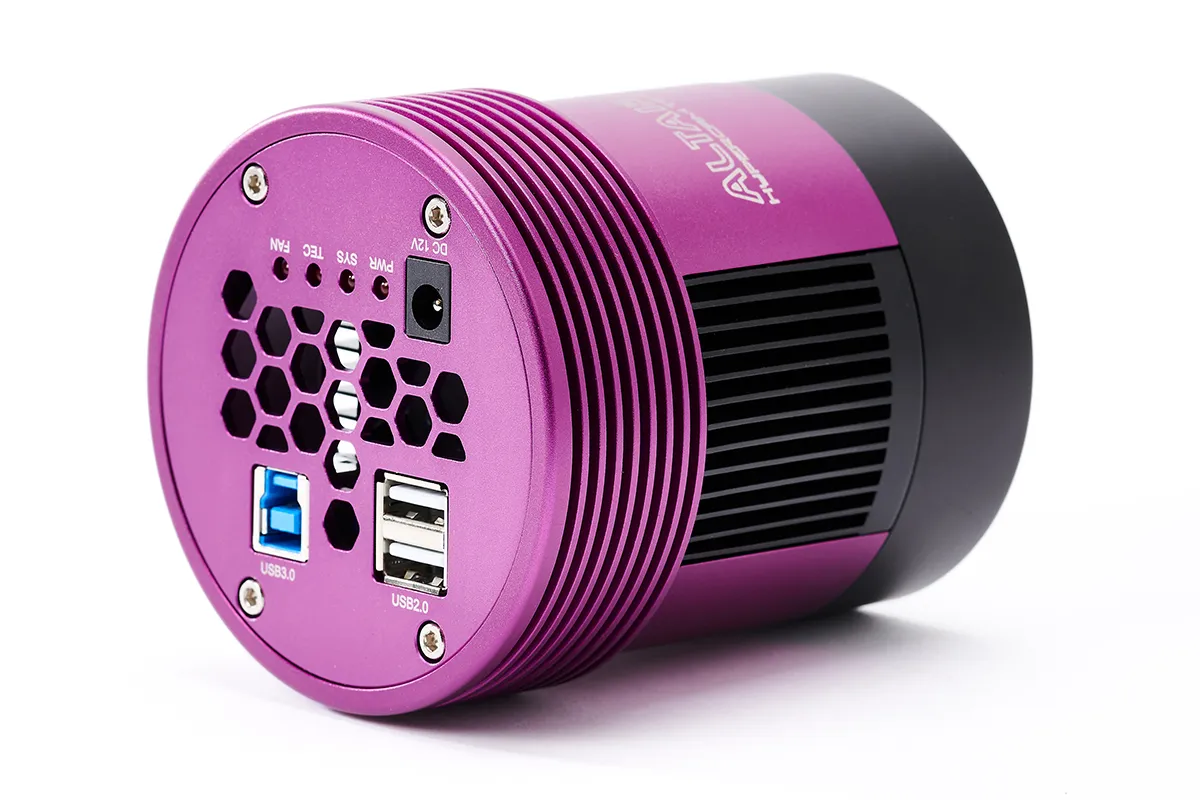The world of astronomical cameras is fast paced and Altair Astro has just released a new model, the Hypercam 115M, a monochrome CMOS camera with thermoelectric (TEC) cooling.
The Hypercam 115M takes grayscale images, requiring separate filters and additional processing to produce pictures with colour.
Although the camera itself is not that difficult to use, the initial learning curve – and extra equipment needed to use with it – will perhaps make it more desirable to those with a determination to pursue astrophotography seriously, rather than beginners with a casual interest in taking snapshots of the night sky.

The sensor and pixel size of the Altair Hypercam 115M are best matched with a medium to longer focal length telescope, so we chose our 150mm, f/7 refractor, a Sky-Watcher Esprit 150ED, and a filter wheel using 2-inch filters.
The camera is a reassuringly solid piece of kit and weighs over half a kilogram, and there is ample M42 x 0.75mm female thread at the front to ensure a connection to other equipment.
Before connecting the camera to our laptop we installed the AltairCapture software, which is included on a CD, although downloads can provide the latest version.
A new version of the ASCOM driver – ASCOM is an industry-standard interface that allows different pieces of astronomical equipment to communicate – became available for the camera during our review period.
This improved the camera’s stability while the large image files are downloading. We tried using the Hypercam 115M with our own imaging software and the ASCOM driver, but we found that some functionality was unavailable.
Thankfully, Altair supplies its own software with full functionality.

Once the camera was running, with the cooling system set to –10°C, we started experimenting with exposure lengths and gain settings on some deep-sky objects.
The 14-bit CMOS sensor provides a wide range of settings, which enabled us to adapt to the sky and Moon conditions on a dynamic basis – by quickly changing settings.
We used our hydrogen-alpha (Ha) filter and higher gain settings to capture faint emission nebulosity, and a lower gain setting for galaxies and globular clusters, which resulted in very smooth, low-noise images.
With the range of filters and exposure variations available, we are convinced that no matter the type or brightness of any particular deep-sky target, the Hypercam 115M can be configured to capture it to a high standard.
Our targets of choice were the Leo Triplet of galaxies, the Great Cluster in Hercules, M13, plus (using our narrowband filter) the open cluster NGC 2244 at the Rosette Nebula’s centre, and the Horsehead Nebula.

One thing to note was that the relatively large file sizes soon started filling up our hard drive, especially when we were taking four sets of images for each target, using Luminance, Red, Green and Blue filters. These files require a robust PC or laptop to process them.
The camera can also be used for on-the-fly image grabbing, which is real time image capture and stacking using the ‘Live stacking’ function in AltairCapture.
With region of interest imaging, a smaller area of the sensor can be used, which enables much higher frame rates to be captured, making the camera attractive for lunar and solar imaging too.
Conditions did not allow us to test this aspect with a live target, but on the bench we selected a 640 x 480 region of interest and noted that the camera was running at 72fps over USB 3.0, demonstrating that the 115M could also produce good quality planetary, lunar, and solar images, making it an all-round performer.
As is common with this type of CMOS camera, long exposures may produce glow artefacts on image edges and a starburst effect.
To negate this we took a series of dark frames – exposures with the lens cap on using the same settings as the actual images – and applied them in the stacking process.
With a good-sized sensor, a wide range of sensitivity adjustment and fine-tuning options, the Hypercam 115M looks set to become the monochrome camera of choice for dedicated astrophotographers.
Altair Hypercam 115M sensor

The key to the versatility and range of the Hypercam 115M is the CMOS sensor at its heart, a Sony IMX492. It is a 4/3 size unit, measuring 23.2mm across the diagonal.
At full resolution it would yield a 47MP image from its tiny pixels, but this wouldn’t be much use for astronomy purposes.
By using a process called binning, four of these micro pixels are combined together to work as one very sensitive unit, producing excellent response for astrophotography use in an 11.6-megapixel file.
The sensor is especially capable in low light applications, having both the STARVIS and Exmor-R trademarks from Sony.
The Exmor-R rating refers to the sensor’s increased sensitivity with low noise characteristics, something that makes these sensors desirable for long exposure photography, while the STARVIS label refers to back-illuminated pixel technology designed for high-quality surveillance imaging, especially in the dark, which is perfect for our requirements.
Altair Hypercam 115M outstanding features
Heated optical window
With very low temperatures possible inside the camera body, there is a risk of dew forming on the outside of the optical window. The window is surrounded by tiny heating elements, which are controllable in AltairCapture. By gently warming the optical window, issues with dew spots are avoidable.
Thermoelectric cooling
The body of the camera is designed to dissipate heat produced by the imaging process, with a quiet fan efficiently pulling air through the heat sink. In addition, the powered active cooling system allows direct control of the camera temperature down to –40°C below ambient, for fully matched light and dark frames.
USB – capabilities and hub
The Hypercam 115M is a USB 3.0 camera, but it’s fully controllable via USB 2.0. On the rear of the camera there are two USB 2.0 ports which may be useful for using short cables to connect simple, low demand accessories like a filter wheel.
AltairCapture software
The free software provided to operate the camera is simple to learn, easy to use, and allows total control of the camera, and TEC system, and adds useful elements to the usability of the camera. For instance, ‘Live stacking’ mode builds images up from individual exposures as they download.
Armoured case
The Hypercam 115M is supplied with a rigid ABS-style protective plastic case with foam padding. It holds the camera and the accompanying accessories, plus a 2-inch nosepiece, a dew control canister, a 12V power supply, a software disc and USB 3.0 cable.
Vital stats
- Price £1,350
- Sensor Sony IMX492 Monochrome CMOS
- Exposure duration 0.1ms (0.0001 seconds) up to 1,000 seconds (Trigger mode)
- Resolution in pixels 4128 x 2808
- Region of interest Yes
- USB port and cable USB 3.0, 1.8m cable (USB 2.0 also supported)
- Power supply 12V DC
- Size 105mm x 85mm
- Weight 580g
- Supplier Altair Astro
- Tel 01263 731 505
- www.altairastro.com
This review first appeared in the June 2021 issue of BBC Sky at Night Magazine.
